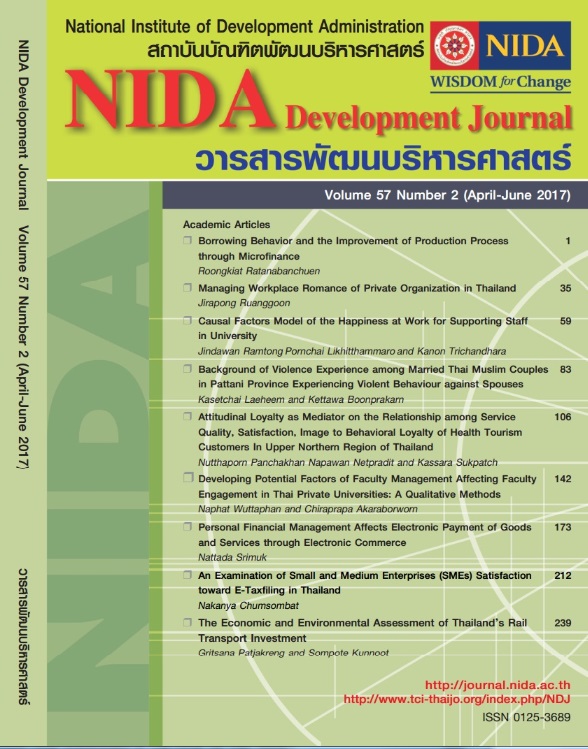Personal Financial Management Affects Electronic Payment of Goods and Services through Electronic Commerce (การจัดการการเงินส่วนบุคคลที่ส่งผลต่อการชำระเงินทางอิเล็กทรอนิกส์ผู้ซื้อสินค้าและบริการผ่านพาณิชย์อิเล็กทรอนิกส์)
Main Article Content
Abstract
The objectives of this research were 1) to study personal financial management of customers who have purchased goods and services through electronic commerce. 2) to study the choices of payment service providers used by customers who have purchased goods and services through electronic commerce. 3) to study risks perception levels and trust level in e-payment of customers who have purchased goods and services through electronic commerce. 4) to develop and examine the goodness of fit a causal model of personal financial managemrnt describing the effects of electronic payment on customers who have purchased goods and services through electronic commerce via the choices of payment service providers, risk perception and trust. And 5) to study the operation of the public and private sector entities with regard to electronic payment for goods and service purchases through electronic commerce in Thailand.
The research methodology for the study was a mixed method approach to data collection and data analysis. It mainly employed quantitative methodology which consisted of the collection of data by using questionnaires from customers who have purchased goods and services through electronic commerce and paid with a credit card online. These populations were selected based on the fact that
their cities represent the highest GPP in the respective 4 regions in Thailand: (Chiang Mai, Songkla, Khonkaen and Bangkok). The minimum number of samples that were used in the analysis were determined by using the structural equation model. Samples have been identified by convenience sampling. Divided quota sampling was employed to derive similar numbers for samples from the 4 regions inThailand. 100 people were selected from the 4 regions in Thailand, for a total of 400 people, in order to study the causal relationship of the personal financial management that affects the electronic payment of goods and services through electronic commerce. Qualitative methodology included in-depth interviews with top management personnel from public and private sectors of electronic payment and electronic commerce in order to study phenomenon and apply the obtained data to describe and confirm the quantitative results.
The research finding were as follows:
1) The personal financial management of customers who purchased good and services through electronic commerce was of a rather high level (= 3.77, S.D.=0.51). The part of cost management was of the highest mean (
=3.83, S.D.=0.63).
2) The choices of payment service provider of customers who have purchased goods and services through electronic commerce was of a rather high level (=3.93, S.D. = 0.60). The part of the benefit was of the highest level (
= 4.00, S.D. = 0.57).
3) The levels of risks perception of e-payment of customers who have purchased goods and services through electronic commerce was of a rather high level (=3.54, S.D.=0.49). The part of time-loss was the highest (
=3.89, S.D.=0.68) and the level of trust in electronic payment was of a rather high level (
=3.88, S.D.=0.54). The part of purchase interaction was the highest (
=3.97, S.D.=0.56).
4) A causal model of how personal financial management affects electronic payment of customers who have purchased goods and services through electronic commerce was fitted to the empirical data, as indicated by the Chi-square = 214.22, p=0.155, df=196, GFI=0.971, AGFI=0.931 and RMR=0.009. The variable that directly affected electronic payment the most was trust (p<0.01). Next were risks perception and the choices of payment service provider with effect sizes of 0.93, 0.88 and 0.64,respectively. The variables in the model accounted for 86%, 78%, 65% and 41% of trust, risk perception, electronic payment and payment service provider, respectively.
5) The operation of the public and private sectors involving personal financial management directly affects trust in and the choice of electronic payment service provider and the perception of risks in electronic payment. Private agencies have developed website layouts to be easy to use with real information. Card association is a network of issuing banks and acquiring banks that have electronic payment channels will have their own security system. This real-time system is modern, reliable and convenient. Sellers of ecommerce would choose an electronic payment service provider based on interest rates, fee, the length of interest free period, other benefits and the service provider’s credibility. Bank of Thailand regulates commercial banks, foreign banks branches and non banks providing electronic payment services to comply with best practice and international standard. In addition, many private and public sector institutions provide electronic payment and personal financial management education for consumers.
บทคัดย่อ
การวิจัยเรื่องนี้มีวัตถุประสงค์ 1) เพื่อศึกษาการจัดการการเงินส่วนบุคคลของผู้ซื้อสินค้าและบริการพาณิชย์อิเลคทรอนิกส์ 2) เพื่อศึกษาการเลือกใช้ตัวกลางการชำระเงินทางอิเล็กทรอนิคส์ของผู้ซื้อสินค้าและบริการพาณิชย์อิเลคทรอนิกส์ 3) เพื่อศึกษาระดับการรับรู้ความเสี่ยงและความไว้ใจในการชำระเงินทางอิเลคทรอนิคส์ของผู้ซื้อสินค้าและบริการพาณิชย์อิเลคทรอนิกส์ 4) เพื่อพัฒนาและตรวจสอบความสอดคล้องของโมเดลเชิงสาเหตุการจัดการการเงินส่วนบุคคลที่ส่งผลต่อการชำระเงินทางอิเลคทรอนิกส์ของผู้ซื้อสินค้าและบริการพาณิชย์อิเลคทรอนิกส์ และ 5) เพื่อศึกษาการดำเนินงานของภาครัฐและภาคเอกชนที่เกี่ยวข้องกับการชำระเงินทางอิเลคทรอนิกส์ในการซื้อสินค้าและบริการพาณิชย์อิเลคทรอนิกส์ของประเทศไทย
งานวิจัยนี้ใช้ระเบียบวิธีวิจัยแบบผสมผสาน(mixed method) ใช้ระเบียบวิธีวิจัยเชิงปริมาณ(quantitative method) เป็นหลัก โดยใช้แบบสอบถามเป็นเครื่องมือในการวิจัย ประชากรเป็นผู้ชำระเงินทางอิเลคทรอนิกด้วยบัตรเครดิตในการซื้อสินค้าและบริการผ่านทางพาณิชย์อิเลคทรอนิกส์ กลุ่มตัวอย่างที่ศึกษา คือ ผู้ซื้อสินค้าและบริการพาณิชย์อิเลคทรอนิกส์และชำระเงินทางอิเลคทรอนิกส์ด้วยบัตรเครดิตโดยผ่านช่องทางออนไลน์ สุ่มกลุ่มตัวอย่างจากประชากรที่ใช้ศึกษาโดยเกณฑ์ในการกำหนดขนาดกลุ่มตัวอย่างมาจากแนวทางของการวิเคราะห์โมเดลสมการโครงสร้างเชิงเส้น (SEM) เพื่อศึกษาความสัมพันธ์เชิงสาเหตุ (causal relationship)โดยสุ่มกลุ่มตัวอย่างโดยวิธีสะดวกจาก 4 ภูมิภาคของประเทศไทยโดยใช้การสุ่มแบบโควต้า ภูมิภาคละ 100 รวมจำนวน 400 ราย เพื่อศึกษาการจัดการการเงินส่วนบุคคลที่ส่งผลต่อการชำระเงินทางอิเลคทรอนิกส์ของผู้ซื้อสินค้าและบริการผ่านทางพาณิชย์อิเลคทรอนิกส์ ที่พัฒนาขึ้นกับข้อมูลเชิงประจักษ์ และระเบียบวิธีวิจัยเชิงคุณภาพ (qualitative method) โดยใช้การสัมภาษณ์เชิงลึกเพื่อศึกษาปรากฏการณ์จริง (Phenomenon study) และนำข้อมูลมาใช้ในการอธิบายและยืนยันข้อมูลในเชิงลึกที่ได้จากการวิจัยเชิงปริมาณ
ผลการวิจัยพบว่า 1) การจัดการการเงินส่วนบุคคลของผู้ซื้อสินค้าและบริการพาณิชย์อิเลคทรอนิกส์ อยู่ในระดับค่อนข้างสูง ( =3.77, S.D.=0.51) โดยด้านการจัดการต้นทุนมีค่าเฉลี่ยสูงสุด (
=3.83, S.D.=0.63) 2) การเลือกใช้ตัวกลางการชำระเงินทางอิเล็กทรอนิคส์ของผู้ซื้อสินค้าและบริการพาณิชย์อิเลคทรอนิกส์ อยู่ในระดับค่อนข้างสูง (
=3.93, S.D.=0.60) โดยด้านสิทธิประโยชน์มีค่าเฉลี่ยสูงสุด (
=4.00, S.D.=0.57) 3) ระดับการรับรู้ความเสี่ยงในการชำระเงินทางอิเลคทรอนิคส์ของผู้ซื้อสินค้าและบริการพาณิชย์อิเลคทรอนิกส์ อยู่ในระดับค่อนข้างสูง (
=3.54, S.D.=0.49) โดยด้านความเสี่ยงสูญเสียเวลามีค่าเฉลี่ยสูงสุด (
=3.89, S.D.=0.68) และระดับความไว้ใจ อยู่ในระดับค่อนข้างสูง (
=3.88, S.D.=0.54) โดยความไว้ใจด้านทำการซื้อสินค้ามีค่าเฉลี่ยสูงสุด (
=3.97, S.D.=0.56) 4) โมเดลเชิงสาเหตุการจัดการการเงินส่วนบุคคลที่ส่งผลต่อการชำระเงินทางอิเลคทรอนิกส์ของผู้ซื้อสินค้าและบริการพาณิชย์อิเลคทรอนิกส์มีความสอดคล้องกับข้อมูลเชิงประจักษ์ (c2 = 214.22, p = 0.155, df = 196, GFI = 0.971, AGFI = 0.931, RMR = 0.009) ตัวแปรที่มีอิทธิพลทางตรงสูงสุดต่อการชำระเงินทางอิเลคทรอนิกส์อย่างมีนัยสำคัญทางสถิติที่ระดับ 0.01 คือ ความไว้ใจ รองลงมา คือ การรับรู้ความเสี่ยงและการเลือกใช้ตัวกลางการชำระเงิน ตามลำดับ โดยมีขนาดอิทธิพลเท่ากับ 0.93 0.88 และ 0.64 ตามลำดับ ตัวแปรในโมเดลสามารถร่วมกันอธิบายความแปรปรวนของความไว้ใจ การรับรู้ความเสี่ยง การชำระเงินทางอิเลคทรอนิกส์ และการเลือกใช้ตัวกลางการชำระเงิน และ ได้ร้อยละ 86, 78, 65 และ 41 ตามลำดับ 5) ผลการดำเนินงานภาครัฐและเอกชนสอดคล้องกับการจัดการเงินส่วนบุคคลส่งผลทางตรงต่อความไว้ใจ การเลือกใช้บริการตัวกลาง และการรับรู้ความเสี่ยงในการชำระเงินทางอิเลคทรอนิกส์ ด้านการความไว้ใจในการชำระเงินทางอิเลคทรอนิกส์ส่งผลทางตรงต่อการชำระเงินทางอิเลคทรอนิกส์ของผู้ซื้อสินค้าและบริการพาณิชย์อิเลคทรอนิกส์ โดยภาคเอกชนมีการพัฒนาข้อมูลหน้าเว็ปไซต์ และออกแบบเว็ปไซต์ให้ผู้บริโภคใช้งานได้ง่าย เข้าใจง่าย รวมถึงกลุ่มผู้ประกอบการบัตรเครดิต(Card association) มีเครือข่ายเชื่อมโยงกับธนาคารผู้ออกบัตร และธนาคารที่รับบัตรในการชำระเงิน มีระบบรักษาความปลอดภัย ใช้เทคโนโลยีที่ทันสมัยชำระเงินทันที บริษัทที่ขายสินค้าและบริการจะมีการเลือกตัวกลางการชำระเงิน (Payment Service Provider) โดยพิจารณาจากอัตราดอกเบี้ยและค่าธรรมเนียมที่ต่ำ ให้ระยะเวลานาน การปลอดดอกเบี้ยในระยะเวลาที่กำหนด และสิทธิประโยชน์ต่างๆ ซึ่งเป็นทางเลือกที่ดีให้กับผู้บริโภค รวมถึงความน่าเชื่อถือของตัวกลางในการชำระเงิน ธนาคารแห่งประเทศไทยกำกับดูแลธนาคารพาณิชย์ ธนาคารต่างประเทศ และธุรกิจที่ไม่ใช่สถาบันการเงิน(non bank)ในการให้บริการการชำระเงินทางอิเลคทรอนิกส์ให้ปฏิบัติให้ดีที่สุดและได้มาตรฐานสากล รวมทั้ง หน่วยงานภาครัฐและเอกชนได้ให้ความรู้เกี่ยวกับการชำระเงินทางอิเลคทรอนิกส์และจัดการการเงินส่วนบุคคลแก่ผู้บริโภค

